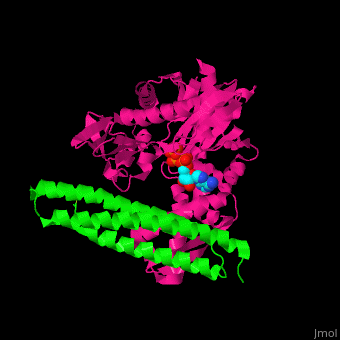BAG protein
From Proteopedia
(Difference between revisions)
| (2 intermediate revisions not shown.) | |||
| Line 3: | Line 3: | ||
== Function == | == Function == | ||
| - | The '''BAG family proteins''' ('''Bcl-2 associated athanogenes''') perform diverse functions. '''BAG-1, BAG-2, BAG-4, BAG-5''' or '''BAG family molecular chaperone regulator''' inhibit the chaperone function of HSC70 and have anti-apoptotic function. <ref>PMID:18264803</ref> | + | The '''BAG family proteins''' ('''Bcl-2 associated athanogenes''') or '''BAG-family molecular chaperone protein''' perform diverse functions. '''BAG-1, BAG-2, BAG-4, BAG-5''' or '''BAG family molecular chaperone regulator''' inhibit the chaperone function of HSC70 and have anti-apoptotic function. <ref>PMID:18264803</ref> |
== Structural highlights == | == Structural highlights == | ||
BAG proteins contain a common BAG domain ca. 45 amino acid long near the C terminal which is conserved. | BAG proteins contain a common BAG domain ca. 45 amino acid long near the C terminal which is conserved. | ||
| - | |||
| - | </StructureSection> | ||
==3D structures of BAG family proteins== | ==3D structures of BAG family proteins== | ||
| + | [[BAG family proteins 3D structures]] | ||
| - | + | </StructureSection> | |
| - | + | ||
| - | + | ||
| - | + | ||
| - | + | ||
| - | + | ||
| - | + | ||
| - | + | ||
| - | + | ||
| - | + | ||
| - | + | ||
| - | + | ||
| - | + | ||
| - | + | ||
| - | + | ||
| - | + | ||
| - | + | ||
| - | + | ||
| - | + | ||
| - | + | ||
| - | + | ||
| - | + | ||
| - | + | ||
| - | + | ||
| - | + | ||
| - | + | ||
| - | + | ||
| - | + | ||
| - | + | ||
| - | + | ||
| - | + | ||
| - | + | ||
| - | + | ||
| - | + | ||
| - | + | ||
| - | + | ||
| - | + | ||
| - | + | ||
| - | + | ||
| - | + | ||
| - | + | ||
| - | + | ||
| - | + | ||
| - | + | ||
| - | + | ||
| - | }} | ||
== References == | == References == | ||
<references/> | <references/> | ||
[[Category: Topic Page]] | [[Category: Topic Page]] | ||
Current revision
| |||||||||||
References
- ↑ Kabbage M, Dickman MB. The BAG proteins: a ubiquitous family of chaperone regulators. Cell Mol Life Sci. 2008 May;65(9):1390-402. doi: 10.1007/s00018-008-7535-2. PMID:18264803 doi:http://dx.doi.org/10.1007/s00018-008-7535-2

